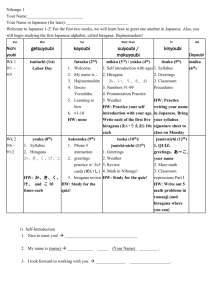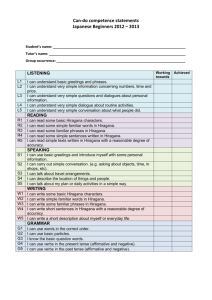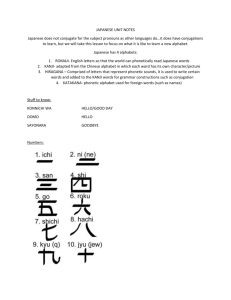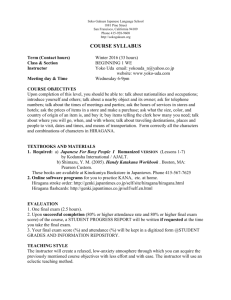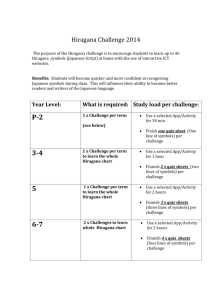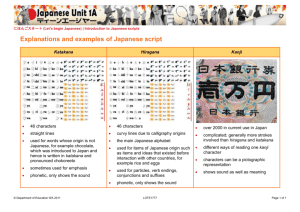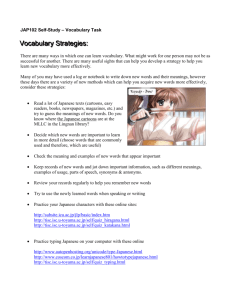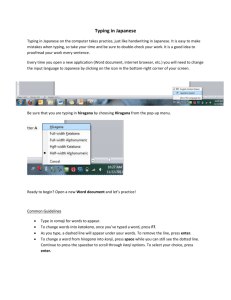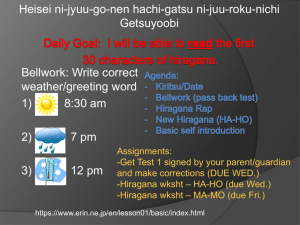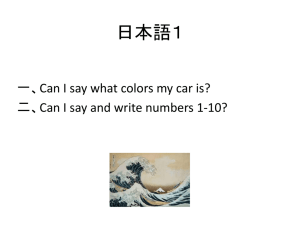JPN1000
advertisement
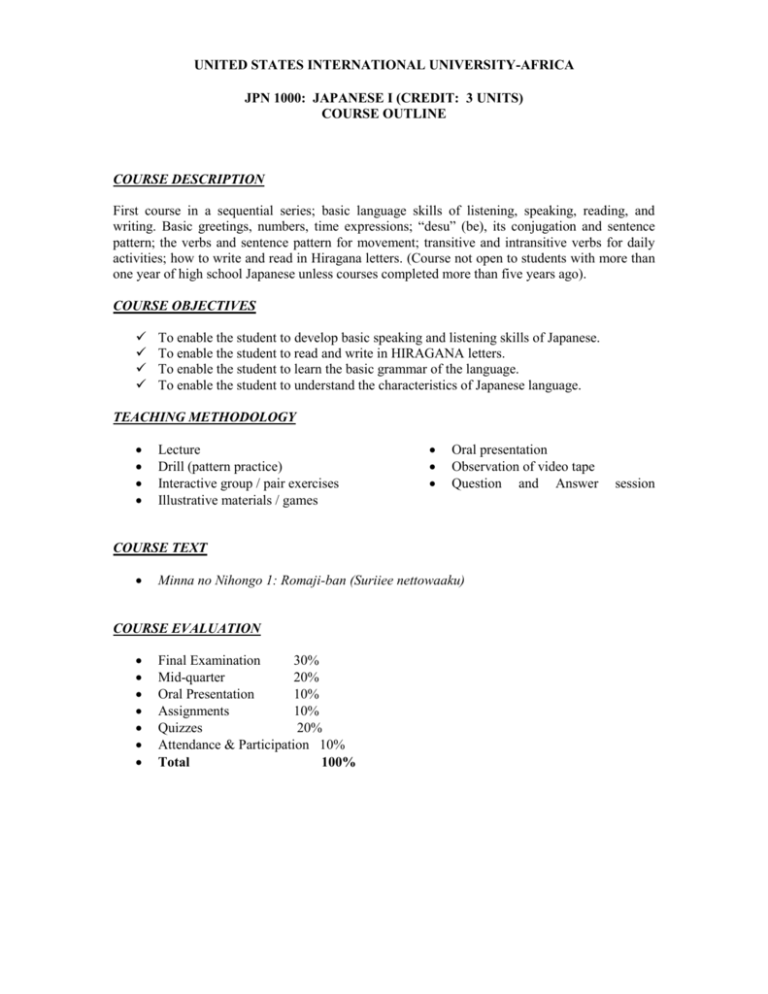
UNITED STATES INTERNATIONAL UNIVERSITY-AFRICA JPN 1000: JAPANESE I (CREDIT: 3 UNITS) COURSE OUTLINE COURSE DESCRIPTION First course in a sequential series; basic language skills of listening, speaking, reading, and writing. Basic greetings, numbers, time expressions; “desu” (be), its conjugation and sentence pattern; the verbs and sentence pattern for movement; transitive and intransitive verbs for daily activities; how to write and read in Hiragana letters. (Course not open to students with more than one year of high school Japanese unless courses completed more than five years ago). COURSE OBJECTIVES To enable the student to develop basic speaking and listening skills of Japanese. To enable the student to read and write in HIRAGANA letters. To enable the student to learn the basic grammar of the language. To enable the student to understand the characteristics of Japanese language. TEACHING METHODOLOGY Lecture Drill (pattern practice) Interactive group / pair exercises Illustrative materials / games Oral presentation Observation of video tape Question and Answer COURSE TEXT Minna no Nihongo 1: Romaji-ban (Suriiee nettowaaku) COURSE EVALUATION Final Examination 30% Mid-quarter 20% Oral Presentation 10% Assignments 10% Quizzes 20% Attendance & Participation 10% Total 100% session GRADING 90-100 A 87-89 A84-86 B+ 80-83 B 77-79 A74-76 B+ 70-73 B67-69 BC+ C C- 64-66 D+ 62-63 D C61-60 67-69D59 & Below F COURSE CONTENT / SCHEDULE Week 1 Week 2 Week 3 Week 4 Week 5 Week 6 Week 7 Week 8 Week 9 Week 10 Week 11 Week 12 Week 13 Course introduction; and the basic greetings and useful daily expressions. The characteristics, pronunciation, and writing systems of Japanese language. Lesson 1: Desu (be), its conjugation, and sentence pattern for desu; particle, wa and ka; the question sentence and answering [I]; and the vocabulary for professions and countries. Lesson 1: The particle mo and no [for belonging]; numbers (0 ~ 99); and how to write Hiragana. Ass. 1 Out Lesson 1: Interactive oral exercises for comprehensive self-introduction, etc. Lesson 2: Pronouns kore / sore / are (this / that); and answering questions [II]. Ass. 1 Due Lesson 2: The particle no [for possession]; and interactive oral exercises for the use of kore / sore / are and the particle no for possession. Ass. 2 Out Lesson 3: Sentence pattern for identifying location; and pronouns for location. Lesson 3: The particle no [for the place of origin]; the number (100 ~); and stating the prices. Ass. 2 Due Lesson 3: Interactive oral exercises: Shopping conversation, etc. Revision Quiz 1 (Hiragana Test) Mid-quarter Exam Lesson 4: Time expression (minutes, hours of day, and days of week); particle kara and made; and intransitive verbs. Lesson 4: The particle ni for specific time; the relative times; and the conjugation of masu-form of verb. Ass. 3 Out Interactive oral exercises: Talking about daily activities. Lesson 5: The sentence pattern for movement (go / come / return); and the particle e, de (for transport] and to [for companion]. Ass. 3 Due Date (days and months); and the integration of date information into the sentences. Lesson 5: Interactive oral exercises: Talking about schedules. Quiz II (Oral Test) Lesson 6: Transitive verbs; and the particle o. Lesson 6: The particle de [for place]; the invitational form of verb; the volitional form of verb; and interrogative + mo + (neg.). Ass. 4 Out Lesson 6: Interactive oral exercises: Talking about daily activities [II] and inviting others for a date. Audio-visual lesson; and additional conversational practice. Ass. 4 Due Oral Presentation Week 14 Revision Final Exam Description of Assignments / Quizzes / Oral Presentation Assignment 1: Practice of writing each Hiragana letter; and writing words in Hiragana. (Handout) Assignment 2: Write all the sentences in Reibun section in Lesson 1 and 2 in Hiragana. Assignment 3: Write about yourself (i.e. name, occupation, nationality and age) and your daily life (i.e. wake up / sleep / study / rest at what time, etc.) in not less than 8 sentences. Write in Japanese (both Hiragana and Roman alphabet). Assignment 4: Compose a dialogue of two persons, in which one invite the other for a date. Write not less than 6 turns of speech for each person. Write in Japanese (both Hiragana and Roman alphabet) as well as in English. Quiz 1: Test for the basic 46 Hiragana letters. Quiz 2: Individual oral test. You will answer the questions about what you will write for the assignment 3. Oral Presentation: A skit based on Assignment 4 with a partner. 2 questions for each student right after the presentation.
